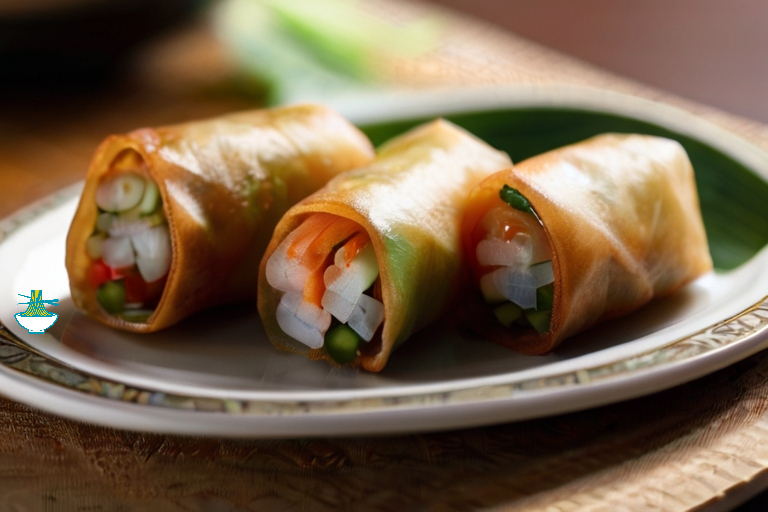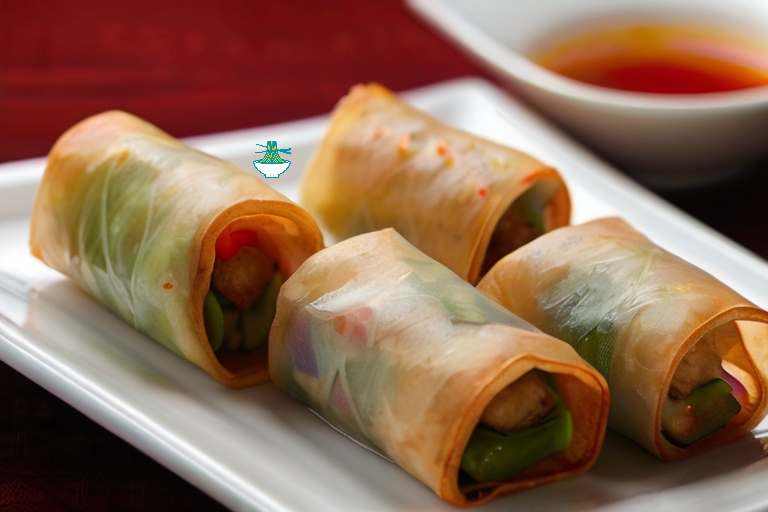Indulge in the delightful crunch and savory flavors of traditional Chinese Spring Rolls. This easy-to-follow recipe guides you through creating these iconic appetizers, featuring a delicate balance of fresh vegetables, aromatic herbs, and your choice of protein, all wrapped in thin, crispy pastry. Perfect for any occasion, whether as a starter for a dinner party or a delightful snack for family gatherings. Serve with your favorite dipping sauce and savor the taste of China in every bite.
Ingredients:
- 10 spring roll wrappers (available at Asian grocery stores)
- 1 cup finely shredded cabbage
- 1 cup shredded carrots
- 1 cup bean sprouts
- 1 cup thinly sliced mushrooms
- 1 cup thinly sliced bamboo shoots
- 1 cup cooked and shredded chicken, pork, or shrimp (optional)
- 2 cloves garlic, minced
- 2 tablespoons soy sauce
- 1 tablespoon oyster sauce
- 1 teaspoon sesame oil
- 1 teaspoon cornstarch mixed with 2 tablespoons water
- Oil for frying
- Salt and pepper to taste

Instructions:
1- In a large skillet or wok, heat a tablespoon of oil over medium-high heat. Add garlic and stir-fry for about 30 seconds until fragrant.
2- Add cabbage, carrots, bean sprouts, mushrooms, and bamboo shoots to the skillet. Stir-fry for 3-4 minutes until the vegetables are slightly softened but still crisp.
3- If using meat or shrimp, add it to the skillet and stir-fry until cooked through.
4- In a small bowl, mix together soy sauce, oyster sauce, and sesame oil. Pour this mixture over the vegetables and meat/shrimp. Stir well to combine.
5- Add the cornstarch-water mixture to the skillet and stir until the sauce thickens slightly. Season with salt and pepper to taste. Remove from heat and let the filling cool completely.
6- To assemble the spring rolls, place a spring roll wrapper on a clean surface. Spoon about 2-3 tablespoons of the filling onto the lower third of the wrapper.
7- Fold the bottom edge of the wrapper over the filling, then fold in the sides, and roll up tightly into a cylinder. Seal the edge with a little water.
8- Heat oil in a deep fryer or large skillet to 350°F (175°C). Fry the spring rolls in batches for about 3-4 minutes, turning occasionally, until golden brown and crispy.
9- Remove the spring rolls from the oil and drain on paper towels. Serve hot with your favorite dipping sauce, such as sweet chili sauce or soy sauce with a dash of vinegar.
Enjoy your homemade Chinese Spring Rolls as a delicious appetizer or snack!
Nutritional Values:
Here's a rough estimate of the nutritional values for the ingredients used in the Chinese Spring Rolls recipe:
Spring Roll Wrappers (10 wrappers):
- Calories: 110 kcal
- Carbohydrates: 23 g
- Protein: 2 g
- Fat: 0 g
- Fiber: 1 g
- Sodium: 320 mg
benefits:
- Provides carbohydrates for energy.
- Low in fat and sodium.
Cabbage (1 cup finely shredded):
- Calories: 22 kcal
- Carbohydrates: 5 g
- Protein: 1 g
- Fat: 0 g
- Fiber: 2 g
- Sodium: 18 mg
benefits:
- Low in calories but high in fiber, promoting digestive health.
- Rich in vitamins C and K, supporting immune function and bone health.
Carrots (1 cup shredded):
- Calories: 45 kcal
- Carbohydrates: 11 g
- Protein: 1 g
- Fat: 0 g
- Fiber: 3 g
- Sodium: 42 mg
benefits:
- Excellent source of beta-carotene, promoting eye health and immunity.
- High in fiber, aiding digestion and promoting satiety.
Bean Sprouts (1 cup):
- Calories: 31 kcal
- Carbohydrates: 6 g
- Protein: 3 g
- Fat: 0 g
- Fiber: 2 g
- Sodium: 6 mg
benefits:
- Low in calories but high in protein, supporting muscle growth and repair.
- Rich in vitamins C and K, supporting immune function and bone health.
Mushrooms (1 cup thinly sliced):
- Calories: 15 kcal
- Carbohydrates: 2 g
- Protein: 2 g
- Fat: 0 g
- Fiber: 1 g
- Sodium: 2 mg
benefits:
- Low in calories but high in protein, supporting muscle growth and repair.
- Rich in antioxidants, protecting cells from damage and reducing inflammation.
Bamboo Shoots (1 cup thinly sliced):
- Calories: 41 kcal
- Carbohydrates: 9 g
- Protein: 3 g
- Fat: 0 g
- Fiber: 4 g
- Sodium: 3 mg
benefits:
- Low in calories but high in fiber, aiding digestion and promoting satiety.
- Contains essential minerals like potassium and manganese, supporting heart health and metabolism.
Cooked Chicken, Pork, or Shrimp (1 cup shredded):
- Calories: Varies depending on the meat/shrimp used.
- Typically, cooked chicken: 231 kcal, 43 g protein, 5 g fat, 0 g carbohydrates, 0 g fiber, 74 mg sodium.
benefits:
- Excellent source of high-quality protein, supporting muscle growth and repair.
- Rich in essential vitamins and minerals like B vitamins and zinc, supporting overall health and immunity.
- Pork and shrimp would have similar nutritional profiles.
Garlic (2 cloves):
- Calories: 9 kcal
- Carbohydrates: 2 g
- Protein: 0 g
- Fat: 0 g
- Fiber: 0 g
- Sodium: 1 mg
benefits:
- Contains compounds like allicin, which may have antibacterial and antiviral properties.
- May help lower cholesterol levels and improve heart health.
Soy Sauce (2 tablespoons):
- Calories: 20 kcal
- Carbohydrates: 2 g
- Protein: 2 g
- Fat: 0 g
- Fiber: 0 g
- Sodium: 1386 mg
benefits:
- Contains essential amino acids, supporting muscle growth and repair.
- Provides flavor without adding significant calories.
Oyster Sauce (1 tablespoon):
- Calories: 9 kcal
- Carbohydrates: 2 g
- Protein: 1 g
- Fat: 0 g
- Fiber: 0 g
- Sodium: 538 mg
benefits:
- Adds rich umami flavor to dishes.
- Contains minerals like iron and zinc, supporting overall health.
Sesame Oil (1 teaspoon):
- Calories: 40 kcal
- Carbohydrates: 0 g
- Protein: 0 g
- Fat: 5 g
- Fiber: 0 g
- Sodium: 0 mg
benefits:
- Rich in healthy fats like omega-6 fatty acids, supporting heart health.
- Adds a nutty flavor to dishes.
Cornstarch (1 teaspoon):
- Calories: 8 kcal
- Carbohydrates: 2 g
- Protein: 0 g
- Fat: 0 g
- Fiber: 0 g
- Sodium: 0 mg
benefits:
- Acts as a thickening agent in sauces, gravies, and fillings.
- Gluten-free alternative to flour for thickening.
These values are approximate and can vary based on factors such as brand, cooking methods, and specific ingredients used.


Comments